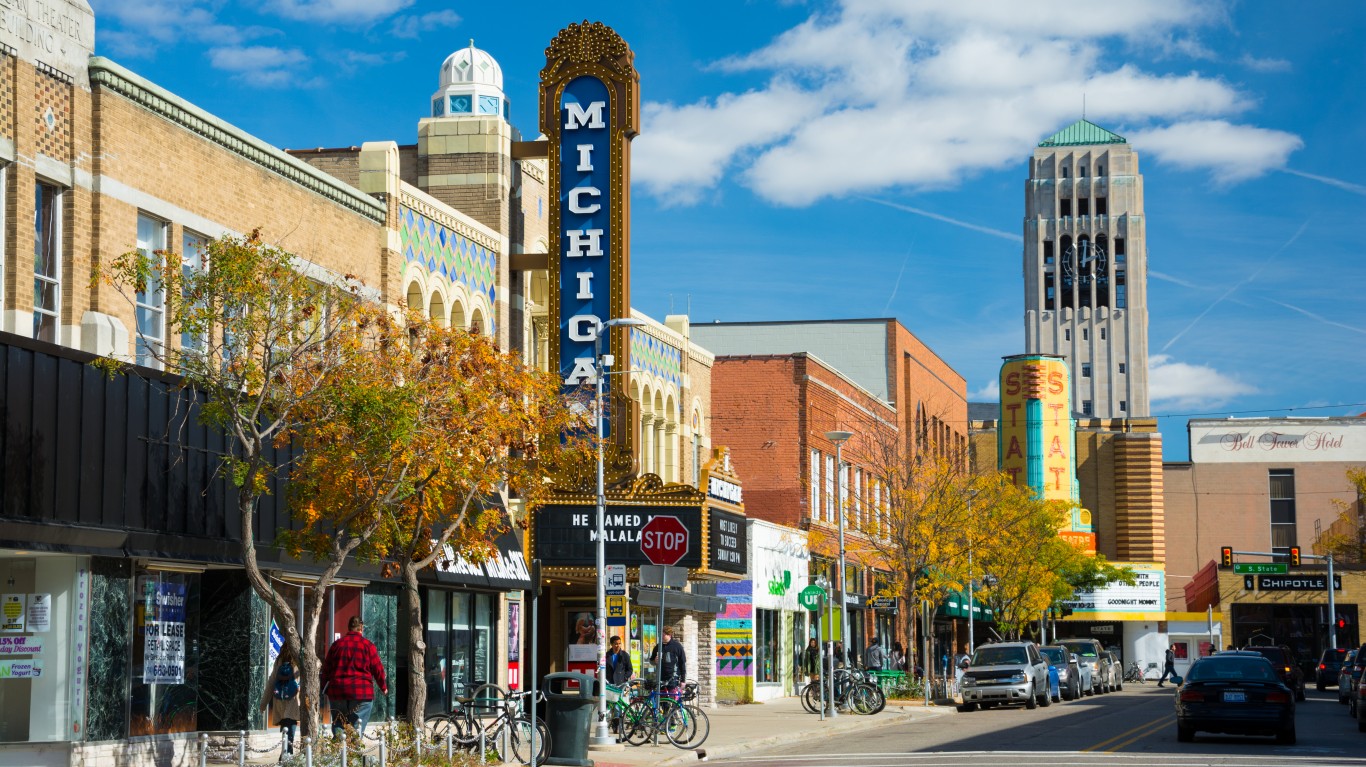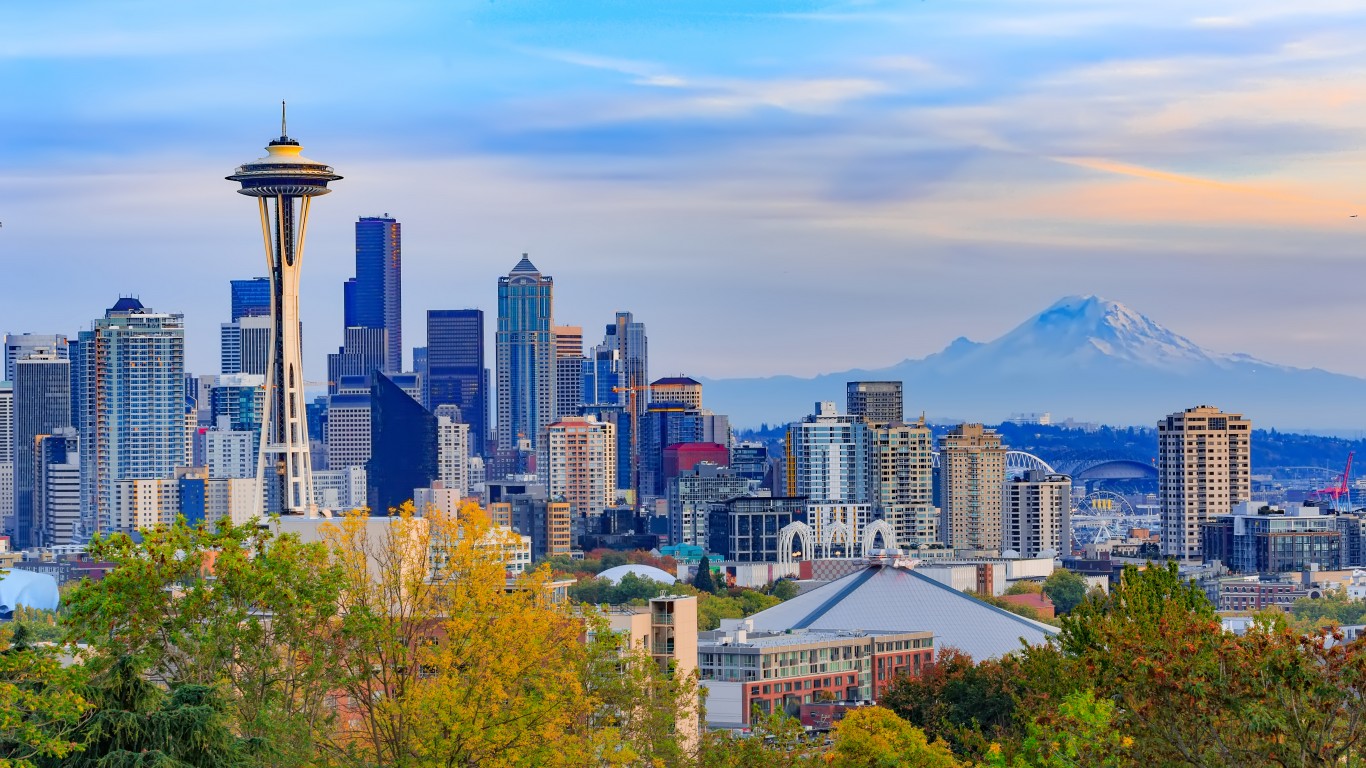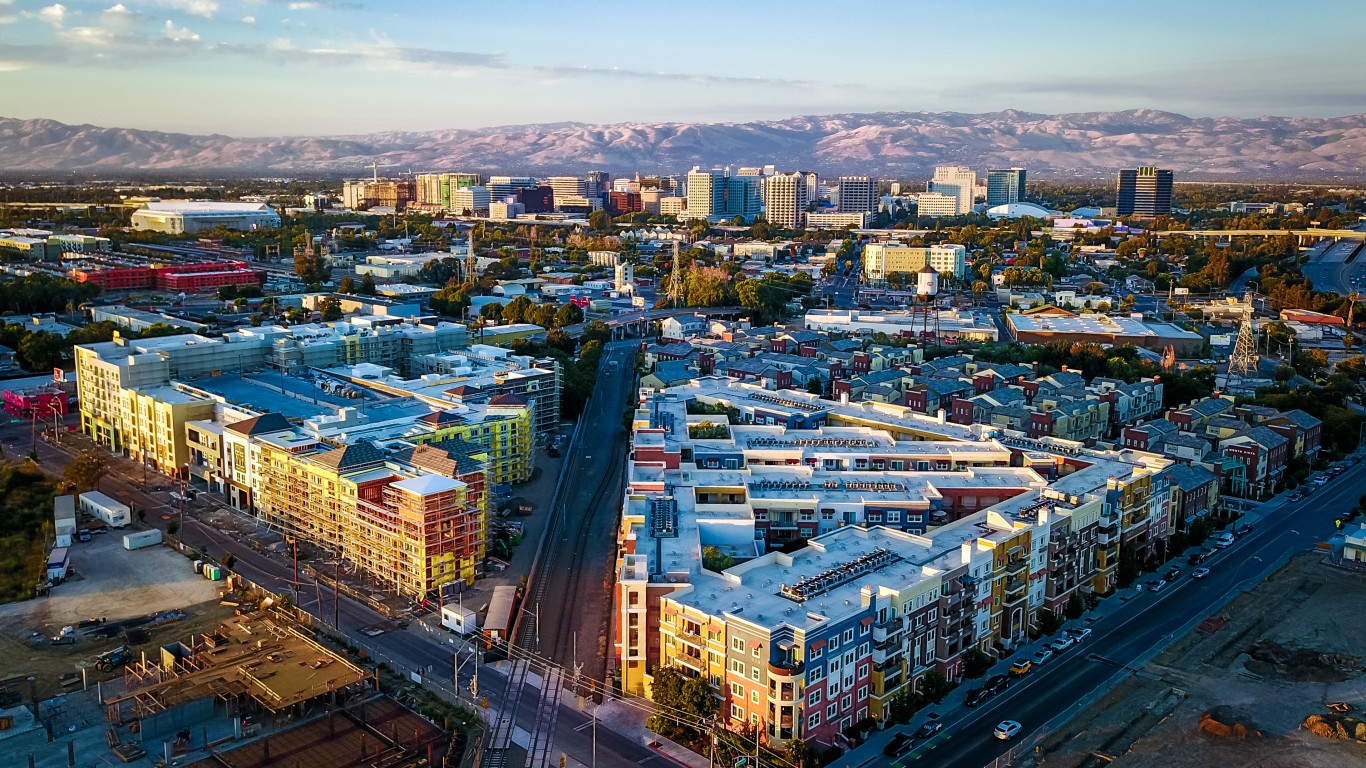Special Report
15 Cities With the Most High-Tech Jobs

Published:
Last Updated:

As the world increasingly relies on advanced technology — in computing, manufacturing, health care, and more — science and technology are becoming inextricably linked in the U.S. job market. More and more, the jobs with better pay and job security are in STEM — science, technology, engineering, and math — fields.
Some areas — most notably California’s Silicon Valley — have become known across the country and the world for their output of high-tech products and services. There are 15 U.S. major metropolitan areas in which at least 9% of the workforce is employed in a STEM field. 24/7 Wall St. reviewed U.S. cities’ labor forces to determine the cities with the most high-tech jobs.
STEM jobs typically pay significantly better than jobs in non-STEM industries. Regardless of education level, those in STEM fields have a median annual income that greatly exceeds that of non-STEM jobs, according to a study from Pew Research Center.
Many of the STEM jobs found in these cities focus on developing artificial intelligence and automation, which could then replace the work many American workers do. About a quarter of the U.S. labor force, 36 million people, hold jobs that could be made obsolete by advancing technology, according to a study by nonprofit public policy organization Brookings Institution.
Click here to see the 15 cities with the most high-tech jobs.
To identify the 15 cities with the most high-tech jobs, 24/7 Wall St. reviewed metropolitan statistical area (MSA)-level data from the Bureau of Labor Statistics’ (BLS) Occupational Employment Statistics (OES) database for 2017 to find the cities with the highest percentage of total jobs that are classified as STEM-intensive. The most common STEM — science, technology, engineering, and math — job in each MSA was the occupation with the highest location quotient — calculated as the occupation with the highest share in the local labor force relative to the national share — for that occupation. Average wages for STEM jobs and total employment were also derived from the OES data.

15. Denver-Aurora-Lakewood, Colorado
> Pct. of workers in STEM fields: 9.2%
> Most common STEM job: Mining and geological engineers, including mining safety engineers
> Avg. STEM median wage: $81,672
> Total employment: 1,443,130
Of the 1.4 million workers in the Denver metropolitan area’s labor force, 9.2% are employed in the fields of science, math, engineering, and technology. Some of the area’s largest employers are telecommunication companies like Dish Networks and CenturyLink as well as some major health care companies like Denver Health and Kaiser Permanente. Denver area STEM workers are most likely to work as a mining or geological engineer.
[in-text-ad]

14. Trenton, New Jersey
> Pct. of workers in STEM fields: 9.3%
> Most common STEM job: Chemists
> Avg. STEM median wage: $89,623
> Total employment: 229,450
The Trenton metropolitan area benefits greatly from its geographical location, near New York and Philadelphia, two of the nation’s major industrial centers. Land, rent, and taxes are significantly lower in Trenton than in New York City, for example, which helps lure regional business to the city. Trenton and the state of New Jersey have made additional financial efforts to draw tech companies to the area. For instance, the New Jersey Economic Development Authority in 2017 approved $17 million in tax credits to encourage technology consulting and data management systems company Maestro Technologies to relocate in Trenton.

13. Ann Arbor, Michigan
> Pct. of workers in STEM fields: 9.5%
> Most common STEM job: Life, Physical, and social science technicians, all other
> Avg. STEM median wage: $75,339
> Total employment: 213,990
Ann Arbor is home to the University of Michigan, one of the top U.S. colleges for engineering and other science programs. This major university provides Ann Arbor businesses with a steady supply of young, educated job seekers each year. Over 54% of adults in Ann Arbor have a college degree, well above the 32% college degree attainment rate nationwide.

12. Palm Bay-Melbourne-Titusville, Florida
> Pct. of workers in STEM fields: 9.9%
> Most common STEM job: Aerospace engineering and operations technicians
> Avg. STEM median wage: $78,031
> Total employment: 206,760
The Palm Bay-Melbourne-Titusville metropolitan area has been home to NASA’s John F. Kennedy Space Center — known as “America’s gateway to space” — since 1962. Not surprisingly, the most common STEM job in the area is aerospace engineering and operations technicians. The area also has a rapidly growing technology industry. The City of Palm Bay organized an Economic Development and External Affairs Division in 2015 to aid promote further growth in the city’s tech industry.
[in-text-ad-2]

11. San Francisco-Oakland-Hayward, California
> Pct. of workers in STEM fields: 10.2%
> Most common STEM job: Biological scientists, all other
> Avg. STEM median wage: $96,660
> Total employment: 2,369,450
California’s Bay Area, home to Oakland, San Francisco, and the surrounding area, is one of just 11 major metro areas in the United States in which at least one in 10 workers are employed in STEM fields. Just north of the San Jose area and Silicon Valley, the Bay Area is home to some of the largest and most recognizable tech companies in the world, including Twitter, Salesforce, and Uber. Yet the STEM field that employs the most Bay Area residents is actually biological science. This field includes scientific researchers, pharmaceutical manufacturers, and diagnostic laboratory workers.

10. Boston-Cambridge-Newton, Massachusetts
> Pct. of workers in STEM fields: 10.4%
> Most common STEM job: Biochemists and biophysicists
> Avg. STEM median wage: $87,432
> Total employment: 2,726,490
While the Greater Boston area has long been known for its higher education institutions, including Harvard University and Massachusetts Institute of Technology, it is now also known for its high tech sector. Major companies such as Amazon, Facebook, Salesforce, and Microsoft have substantial presences in the metropolitan area, along with many others. The most common STEM job in the area is biochemists and biophysicists, which is perhaps unsurprising considering the region’s reputation for exceptional medical institutions. Venture capitalists have entered Boston’s healthtech industry and, according to a 2017 article in the Boston Business Journal, total invested capital in the field since 2013 has reached nearly $1 billion.
[in-text-ad]

9. Austin-Round Rock, Texas
> Pct. of workers in STEM fields: 10.6%
> Most common STEM job: Materials scientists
> Avg. STEM median wage: $79,665
> Total employment: 996,540
The most common STEM job in the Austin, Texas, area is materials scientist, or someone who analyzes how substances interact, often to test the quality of manufactured goods. Austin materials scientists are typically paid well — most workers in the field earn more than $140,000 per year. The Austin area also is home to several major tech companies like Dell. Apple and IBM each also employ an estimated 6,000 people apiece in the area.

8. Raleigh, North Carolina
> Pct. of workers in STEM fields: 10.8%
> Most common STEM job: Agricultural sciences teachers, postsecondary
> Avg. STEM median wage: $76,278
> Total employment: 606,510
The area surrounding and including North Carolina’s capital has become one of the nation’s top locations for high tech jobs. The city of Raleigh is home to software company Red Hat, and tech companies such as IBM and Cisco Systems employ thousands in the metro area. Additionally, the area is home to numerous bioscience companies that contribute to developments in health care, faster diagnostics, and sustainable food production.

7. Seattle-Tacoma-Bellevue, Washington
> Pct. of workers in STEM fields: 11.0%
> Most common STEM job: Software developers, applications
> Avg. STEM median wage: $82,793
> Total employment: 1,944,160
Nearly one in nine Seattle area workers is employed in a STEM field, with software development being the most common. Thanks to the success of Amazon and Microsoft, Seattle is one of the nation’s premiere tech hubs. There are more than 48,000 software developers in the Seattle metro area, accounting for nearly a quarter of STEM workers in the area.
[in-text-ad-2]

6. Washington-Arlington-Alexandria, District of Columbia
> Pct. of workers in STEM fields: 11.7%
> Most common STEM job: Astronomers
> Avg. STEM median wage: $93,481
> Total employment: 3,103,530
Washington D.C. is one of the country’s most populous metro areas. Due in large part to its size, the area has the second greatest number of workers employed in STEM occupations, behind only the New York metro area. The D.C. metro area is home to a thriving biotech industry, thanks to its research-heavy universities and major labs, including the Institute for Bioscience and Biotechnology Research.

5. Durham-Chapel Hill, North Carolina
> Pct. of workers in STEM fields: 12.3%
> Most common STEM job: Natural sciences managers
> Avg. STEM median wage: $81,911
> Total employment: 298,540
The Durham-Chapel Hill region of North Carolina is part of what is known as the Research Triangle. This area’s three major universities churn out thousands of STEM program graduates each year who, in turn, attract businesses looking to employ these workers. The area’s most common STEM job is natural sciences manager, or someone who supervises and manages scientific research and development. The region has hundreds of research companies specializing in fields such as life sciences, clean energy, and agriculture.
[in-text-ad]

4. Boulder, Colorado
> Pct. of workers in STEM fields: 15.7%
> Most common STEM job: Physicists
> Avg. STEM median wage: $86,609
> Total employment: 178,460
The Boulder metro area — home to the University of Colorado — is another college town with a bustling tech sector. Among the companies driving employment in the industry are Google and Amazon, both of which have large satellite offices there. While the median salary for a STEM worker in the region is more than $86,600 per year, the median home value is $504,800 — more than double the median value for the entire country.

3. Huntsville, Alabama
> Pct. of workers in STEM fields: 15.7%
> Most common STEM job: Aerospace engineers
> Avg. STEM median wage: $80,483
> Total employment: 222,080
There are nearly 4,000 aerospace engineers working in Huntsville, Alabama, more than any other major metro area in the United States. Aerospace and aviation companies like Boeing and Blue Origin employ thousands of those workers and have plans for expansion in the near future. Huntsville has a rich history in aerospace engineering, as NASA’s Saturn V rockets were constructed there in 1960s.

2. San Jose-Sunnyvale-Santa Clara, California
> Pct. of workers in STEM fields: 20.1%
> Most common STEM job: Computer hardware engineers
> Avg. STEM median wage: $99,422
> Total employment: 1,089,070
It should come as no surprise that the San Jose area, which includes Silicon Valley, ranks as one of the areas with the highest share of high-tech jobs. Over one in five workers in the metro area are employed in science, math, engineering, and tech. Nearly 10,000 residents work as computer hardware engineers, the most common STEM job in the area. Many of the most well-known tech companies, like Google and Apple, are located in the region. More than half of the San Jose area’s workforce holds a college degree, making them more qualified for better-paying positions.
[in-text-ad-2]

1. California-Lexington Park, Maryland
> Pct. of workers in STEM fields: 24.8%
> Most common STEM job: Aerospace engineers
> Avg. STEM median wage: $102,826
> Total employment: 45,460
California-Lexington Park is the city with the highest share of high-tech jobs. Nearly a quarter of the area’s entire workforce is employed in STEM fields, well ahead of any other U.S. metro area. California-Lexington Park also has the highest median STEM wage in the country at $102,826 — making it the only metro area where most STEM employees make six figures. The metro area is near Washington D.C. and a high concentration of defense contractors. BAE Systems, Boeing, Northrop Grumman, and Lockheed Martin are some of the area’s biggest employers, and not surprisingly, aerospace engineers is the most common STEM job.
The average American spends $17,274 on debit cards a year, and it’s a HUGE mistake. First, debit cards don’t have the same fraud protections as credit cards. Once your money is gone, it’s gone. But more importantly you can actually get something back from this spending every time you swipe.
Issuers are handing out wild bonuses right now. With some you can earn up to 5% back on every purchase. That’s like getting a 5% discount on everything you buy!
Our top pick is kind of hard to imagine. Not only does it pay up to 5% back, it also includes a $200 cash back reward in the first six months, a 0% intro APR, and…. $0 annual fee. It’s quite literally free money for any one that uses a card regularly. Click here to learn more!
Flywheel Publishing has partnered with CardRatings to provide coverage of credit card products. Flywheel Publishing and CardRatings may receive a commission from card issuers.
Thank you for reading! Have some feedback for us?
Contact the 24/7 Wall St. editorial team.